Buttery Rehabilitation: Ethical Considerations, Risk Management, and Quality Care
VerifiedAdded on 2023/06/03
|12
|2857
|338
AI Summary
This report focuses on Buttery Rehabilitation, a community-based program for treating drug and alcohol addiction. It covers ethical considerations, risk management, and quality care standards. The program is located in Binna Burra near Bangalow the Byron Bay hinterland in Northern NSW, Australia. The report discusses the four principles of ethical care, risk management strategies, and adherence to national safety and quality standards. It concludes with suggestions for improving the program.
Contribute Materials
Your contribution can guide someone’s learning journey. Share your
documents today.
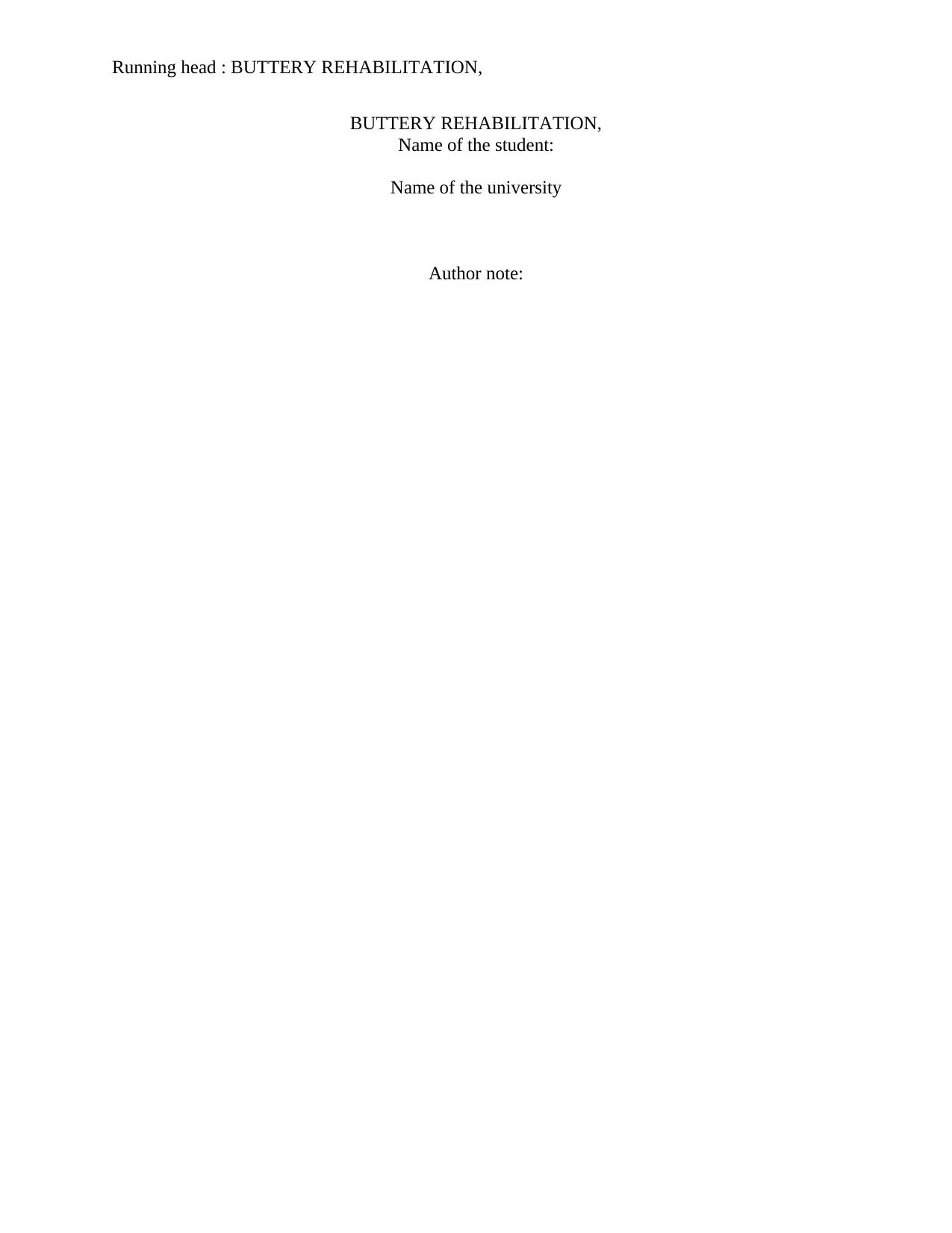
Running head : BUTTERY REHABILITATION,
BUTTERY REHABILITATION,
Name of the student:
Name of the university
Author note:
BUTTERY REHABILITATION,
Name of the student:
Name of the university
Author note:
Secure Best Marks with AI Grader
Need help grading? Try our AI Grader for instant feedback on your assignments.
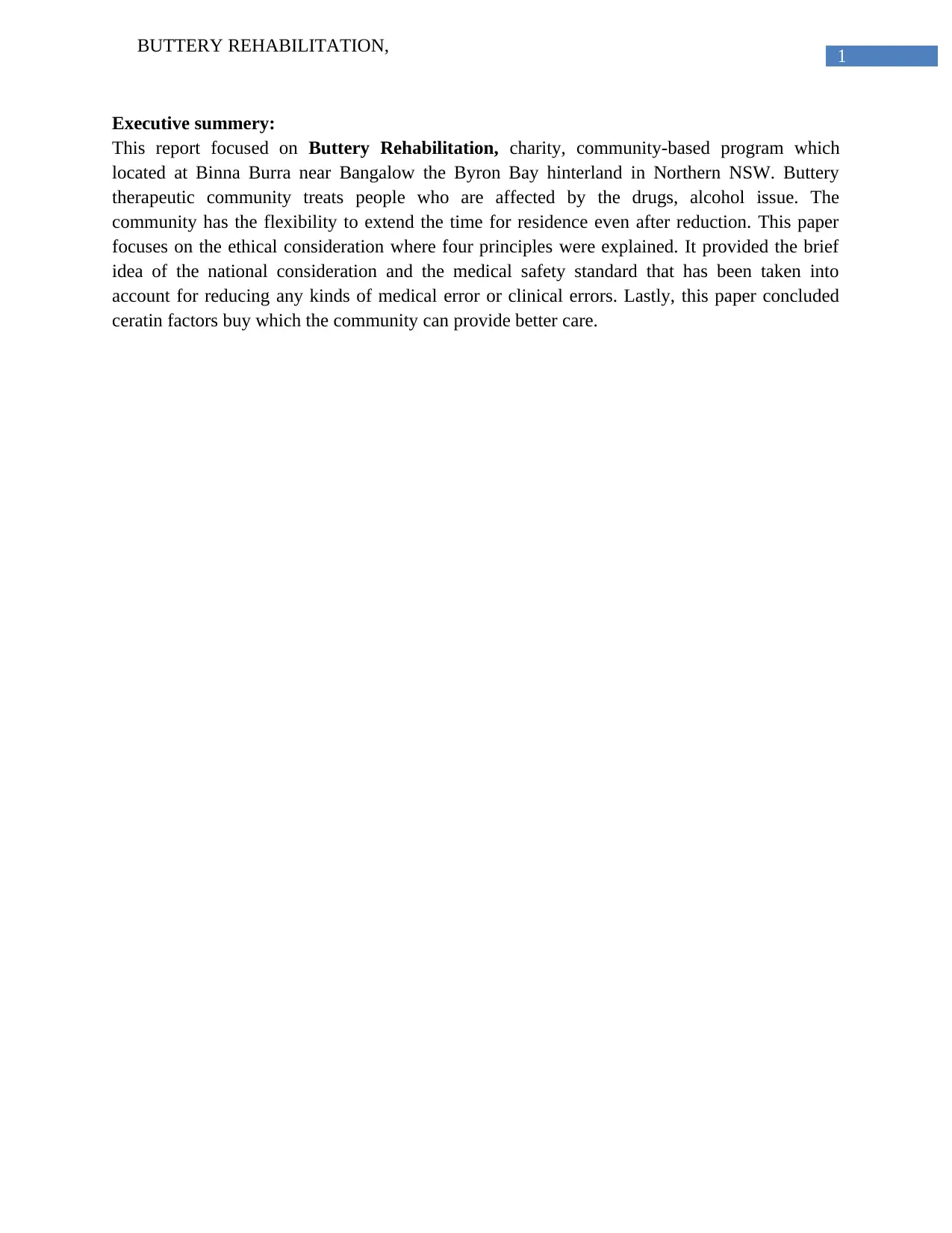
1
BUTTERY REHABILITATION,
Executive summery:
This report focused on Buttery Rehabilitation, charity, community-based program which
located at Binna Burra near Bangalow the Byron Bay hinterland in Northern NSW. Buttery
therapeutic community treats people who are affected by the drugs, alcohol issue. The
community has the flexibility to extend the time for residence even after reduction. This paper
focuses on the ethical consideration where four principles were explained. It provided the brief
idea of the national consideration and the medical safety standard that has been taken into
account for reducing any kinds of medical error or clinical errors. Lastly, this paper concluded
ceratin factors buy which the community can provide better care.
BUTTERY REHABILITATION,
Executive summery:
This report focused on Buttery Rehabilitation, charity, community-based program which
located at Binna Burra near Bangalow the Byron Bay hinterland in Northern NSW. Buttery
therapeutic community treats people who are affected by the drugs, alcohol issue. The
community has the flexibility to extend the time for residence even after reduction. This paper
focuses on the ethical consideration where four principles were explained. It provided the brief
idea of the national consideration and the medical safety standard that has been taken into
account for reducing any kinds of medical error or clinical errors. Lastly, this paper concluded
ceratin factors buy which the community can provide better care.
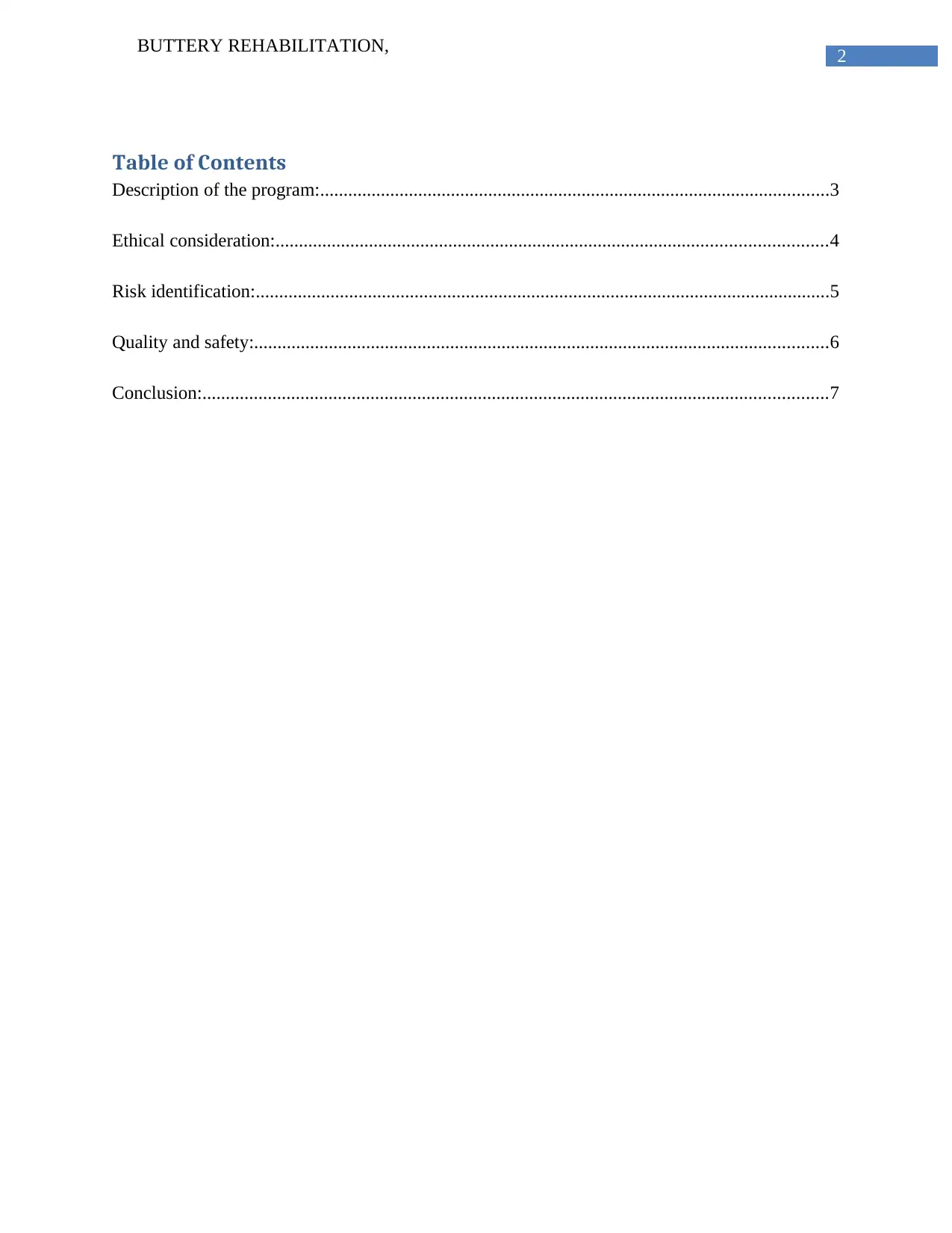
2
BUTTERY REHABILITATION,
Table of Contents
Description of the program:.............................................................................................................3
Ethical consideration:......................................................................................................................4
Risk identification:...........................................................................................................................5
Quality and safety:...........................................................................................................................6
Conclusion:......................................................................................................................................7
BUTTERY REHABILITATION,
Table of Contents
Description of the program:.............................................................................................................3
Ethical consideration:......................................................................................................................4
Risk identification:...........................................................................................................................5
Quality and safety:...........................................................................................................................6
Conclusion:......................................................................................................................................7
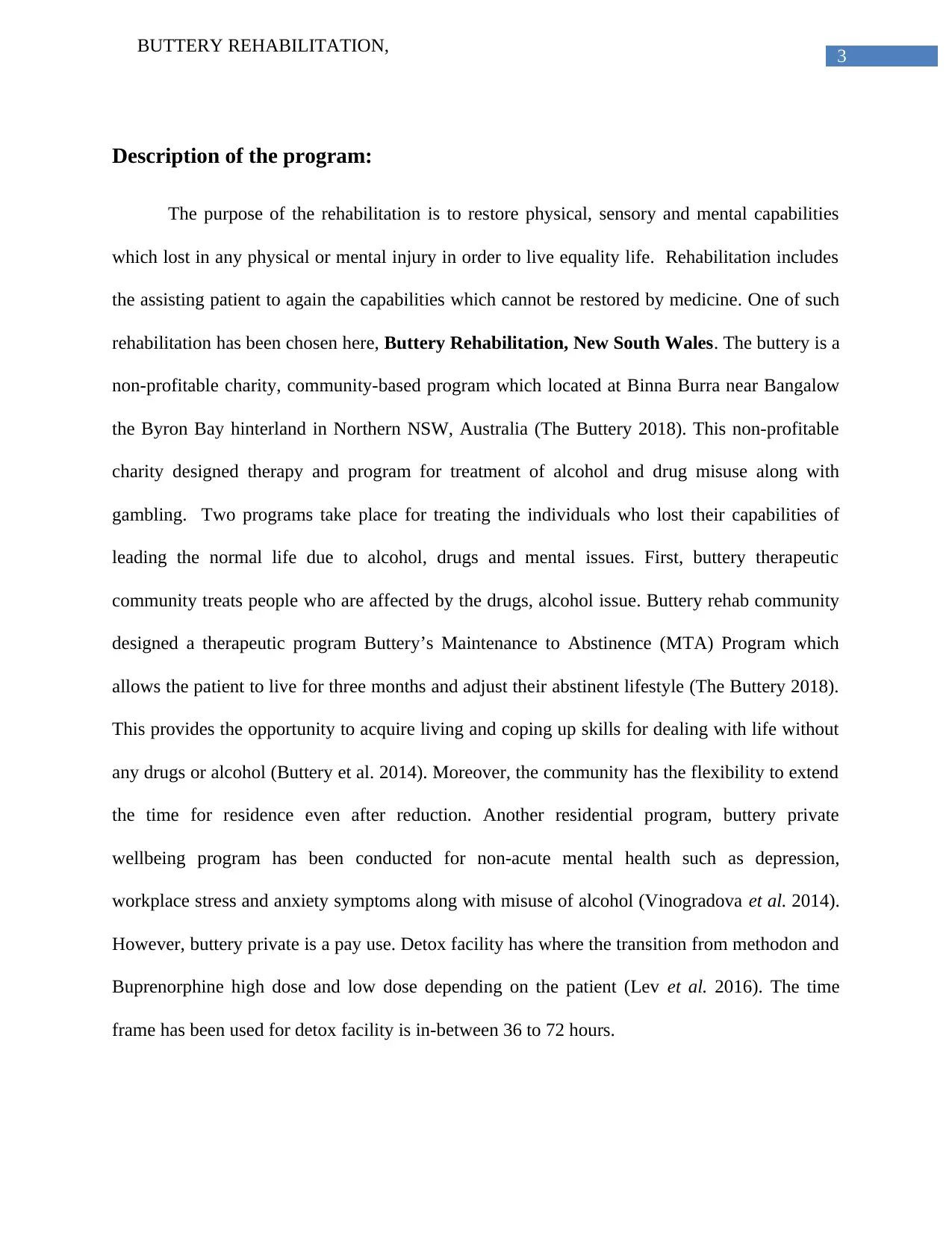
3
BUTTERY REHABILITATION,
Description of the program:
The purpose of the rehabilitation is to restore physical, sensory and mental capabilities
which lost in any physical or mental injury in order to live equality life. Rehabilitation includes
the assisting patient to again the capabilities which cannot be restored by medicine. One of such
rehabilitation has been chosen here, Buttery Rehabilitation, New South Wales. The buttery is a
non-profitable charity, community-based program which located at Binna Burra near Bangalow
the Byron Bay hinterland in Northern NSW, Australia (The Buttery 2018). This non-profitable
charity designed therapy and program for treatment of alcohol and drug misuse along with
gambling. Two programs take place for treating the individuals who lost their capabilities of
leading the normal life due to alcohol, drugs and mental issues. First, buttery therapeutic
community treats people who are affected by the drugs, alcohol issue. Buttery rehab community
designed a therapeutic program Buttery’s Maintenance to Abstinence (MTA) Program which
allows the patient to live for three months and adjust their abstinent lifestyle (The Buttery 2018).
This provides the opportunity to acquire living and coping up skills for dealing with life without
any drugs or alcohol (Buttery et al. 2014). Moreover, the community has the flexibility to extend
the time for residence even after reduction. Another residential program, buttery private
wellbeing program has been conducted for non-acute mental health such as depression,
workplace stress and anxiety symptoms along with misuse of alcohol (Vinogradova et al. 2014).
However, buttery private is a pay use. Detox facility has where the transition from methodon and
Buprenorphine high dose and low dose depending on the patient (Lev et al. 2016). The time
frame has been used for detox facility is in-between 36 to 72 hours.
BUTTERY REHABILITATION,
Description of the program:
The purpose of the rehabilitation is to restore physical, sensory and mental capabilities
which lost in any physical or mental injury in order to live equality life. Rehabilitation includes
the assisting patient to again the capabilities which cannot be restored by medicine. One of such
rehabilitation has been chosen here, Buttery Rehabilitation, New South Wales. The buttery is a
non-profitable charity, community-based program which located at Binna Burra near Bangalow
the Byron Bay hinterland in Northern NSW, Australia (The Buttery 2018). This non-profitable
charity designed therapy and program for treatment of alcohol and drug misuse along with
gambling. Two programs take place for treating the individuals who lost their capabilities of
leading the normal life due to alcohol, drugs and mental issues. First, buttery therapeutic
community treats people who are affected by the drugs, alcohol issue. Buttery rehab community
designed a therapeutic program Buttery’s Maintenance to Abstinence (MTA) Program which
allows the patient to live for three months and adjust their abstinent lifestyle (The Buttery 2018).
This provides the opportunity to acquire living and coping up skills for dealing with life without
any drugs or alcohol (Buttery et al. 2014). Moreover, the community has the flexibility to extend
the time for residence even after reduction. Another residential program, buttery private
wellbeing program has been conducted for non-acute mental health such as depression,
workplace stress and anxiety symptoms along with misuse of alcohol (Vinogradova et al. 2014).
However, buttery private is a pay use. Detox facility has where the transition from methodon and
Buprenorphine high dose and low dose depending on the patient (Lev et al. 2016). The time
frame has been used for detox facility is in-between 36 to 72 hours.
Secure Best Marks with AI Grader
Need help grading? Try our AI Grader for instant feedback on your assignments.
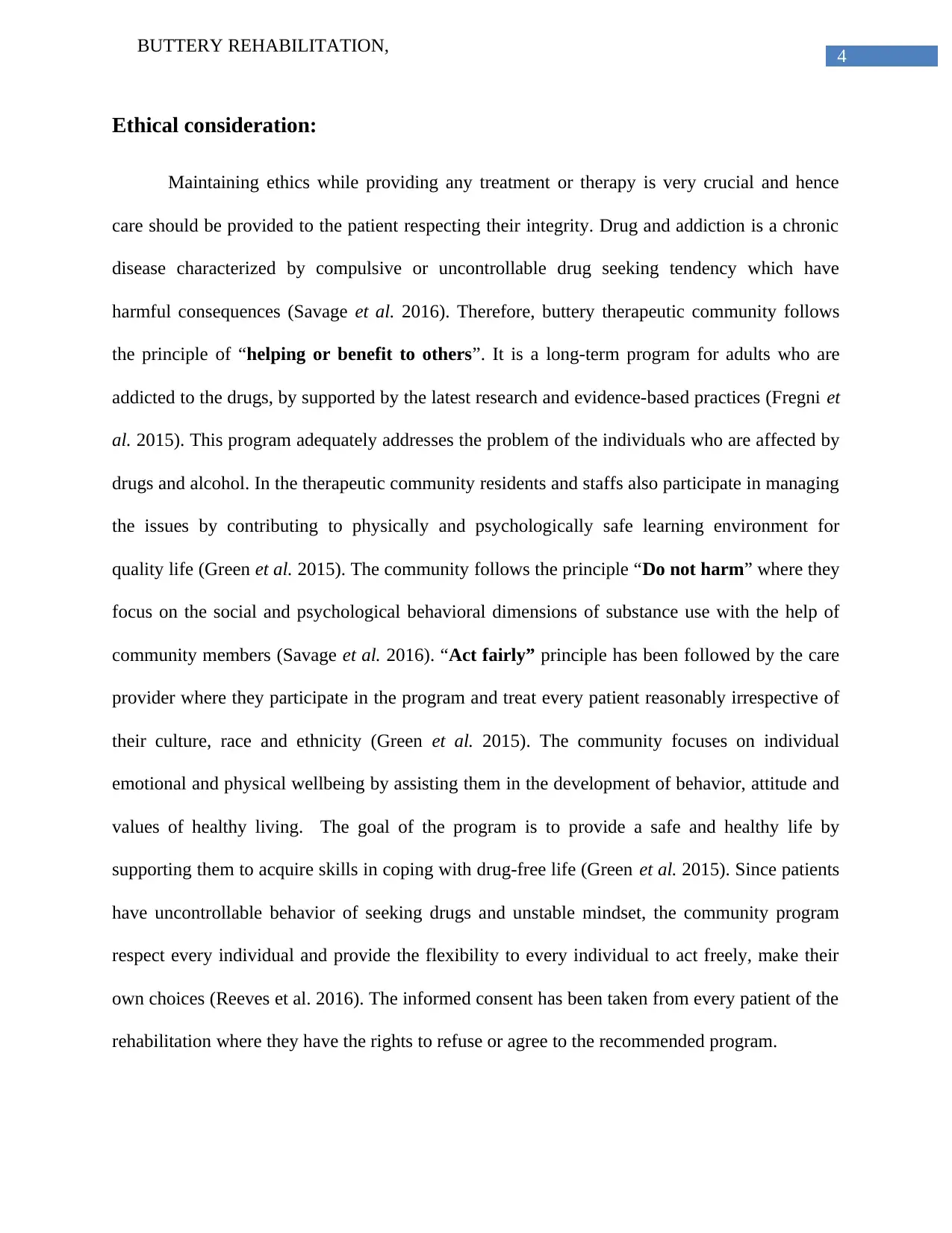
4
BUTTERY REHABILITATION,
Ethical consideration:
Maintaining ethics while providing any treatment or therapy is very crucial and hence
care should be provided to the patient respecting their integrity. Drug and addiction is a chronic
disease characterized by compulsive or uncontrollable drug seeking tendency which have
harmful consequences (Savage et al. 2016). Therefore, buttery therapeutic community follows
the principle of “helping or benefit to others”. It is a long-term program for adults who are
addicted to the drugs, by supported by the latest research and evidence-based practices (Fregni et
al. 2015). This program adequately addresses the problem of the individuals who are affected by
drugs and alcohol. In the therapeutic community residents and staffs also participate in managing
the issues by contributing to physically and psychologically safe learning environment for
quality life (Green et al. 2015). The community follows the principle “Do not harm” where they
focus on the social and psychological behavioral dimensions of substance use with the help of
community members (Savage et al. 2016). “Act fairly” principle has been followed by the care
provider where they participate in the program and treat every patient reasonably irrespective of
their culture, race and ethnicity (Green et al. 2015). The community focuses on individual
emotional and physical wellbeing by assisting them in the development of behavior, attitude and
values of healthy living. The goal of the program is to provide a safe and healthy life by
supporting them to acquire skills in coping with drug-free life (Green et al. 2015). Since patients
have uncontrollable behavior of seeking drugs and unstable mindset, the community program
respect every individual and provide the flexibility to every individual to act freely, make their
own choices (Reeves et al. 2016). The informed consent has been taken from every patient of the
rehabilitation where they have the rights to refuse or agree to the recommended program.
BUTTERY REHABILITATION,
Ethical consideration:
Maintaining ethics while providing any treatment or therapy is very crucial and hence
care should be provided to the patient respecting their integrity. Drug and addiction is a chronic
disease characterized by compulsive or uncontrollable drug seeking tendency which have
harmful consequences (Savage et al. 2016). Therefore, buttery therapeutic community follows
the principle of “helping or benefit to others”. It is a long-term program for adults who are
addicted to the drugs, by supported by the latest research and evidence-based practices (Fregni et
al. 2015). This program adequately addresses the problem of the individuals who are affected by
drugs and alcohol. In the therapeutic community residents and staffs also participate in managing
the issues by contributing to physically and psychologically safe learning environment for
quality life (Green et al. 2015). The community follows the principle “Do not harm” where they
focus on the social and psychological behavioral dimensions of substance use with the help of
community members (Savage et al. 2016). “Act fairly” principle has been followed by the care
provider where they participate in the program and treat every patient reasonably irrespective of
their culture, race and ethnicity (Green et al. 2015). The community focuses on individual
emotional and physical wellbeing by assisting them in the development of behavior, attitude and
values of healthy living. The goal of the program is to provide a safe and healthy life by
supporting them to acquire skills in coping with drug-free life (Green et al. 2015). Since patients
have uncontrollable behavior of seeking drugs and unstable mindset, the community program
respect every individual and provide the flexibility to every individual to act freely, make their
own choices (Reeves et al. 2016). The informed consent has been taken from every patient of the
rehabilitation where they have the rights to refuse or agree to the recommended program.
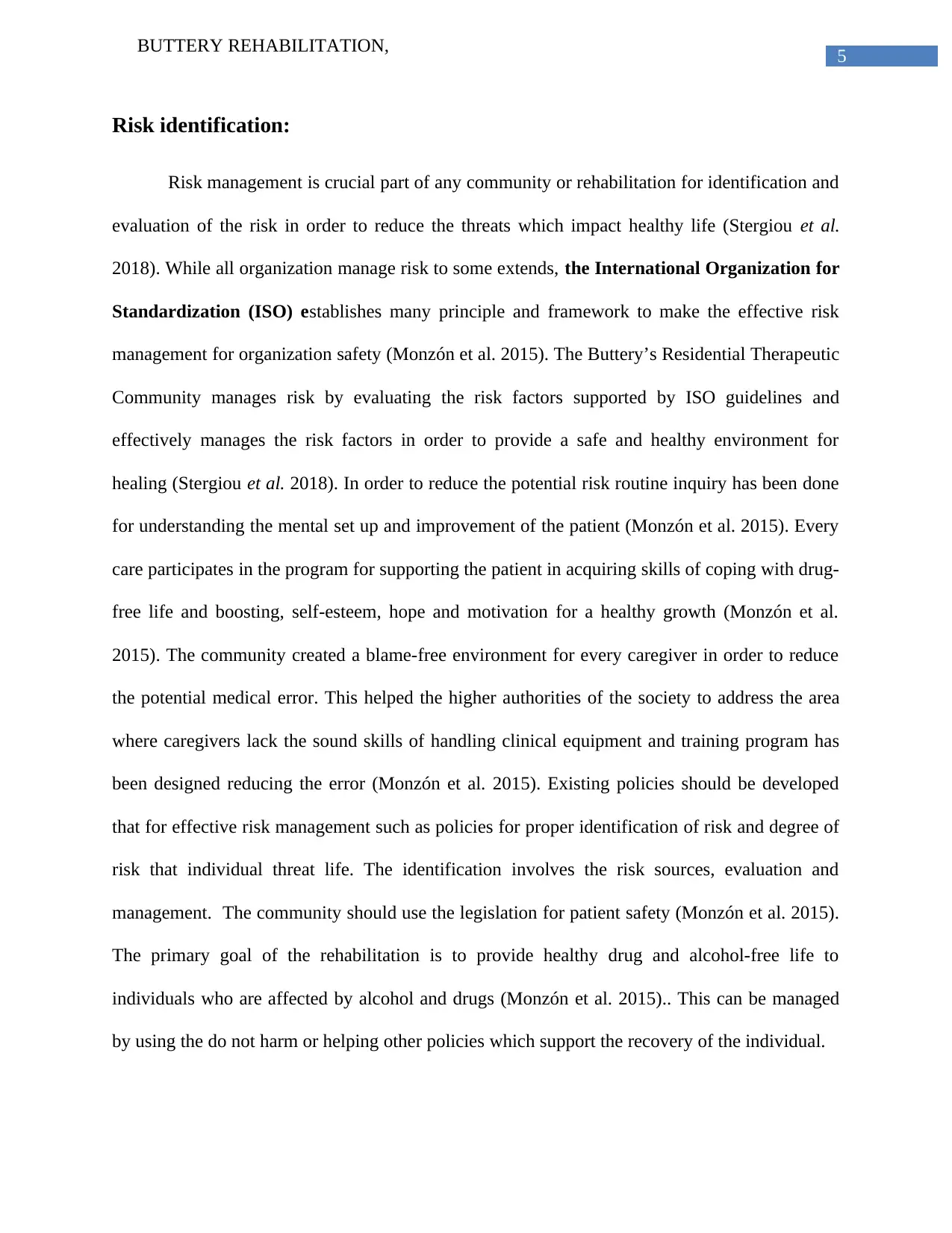
5
BUTTERY REHABILITATION,
Risk identification:
Risk management is crucial part of any community or rehabilitation for identification and
evaluation of the risk in order to reduce the threats which impact healthy life (Stergiou et al.
2018). While all organization manage risk to some extends, the International Organization for
Standardization (ISO) establishes many principle and framework to make the effective risk
management for organization safety (Monzón et al. 2015). The Buttery’s Residential Therapeutic
Community manages risk by evaluating the risk factors supported by ISO guidelines and
effectively manages the risk factors in order to provide a safe and healthy environment for
healing (Stergiou et al. 2018). In order to reduce the potential risk routine inquiry has been done
for understanding the mental set up and improvement of the patient (Monzón et al. 2015). Every
care participates in the program for supporting the patient in acquiring skills of coping with drug-
free life and boosting, self-esteem, hope and motivation for a healthy growth (Monzón et al.
2015). The community created a blame-free environment for every caregiver in order to reduce
the potential medical error. This helped the higher authorities of the society to address the area
where caregivers lack the sound skills of handling clinical equipment and training program has
been designed reducing the error (Monzón et al. 2015). Existing policies should be developed
that for effective risk management such as policies for proper identification of risk and degree of
risk that individual threat life. The identification involves the risk sources, evaluation and
management. The community should use the legislation for patient safety (Monzón et al. 2015).
The primary goal of the rehabilitation is to provide healthy drug and alcohol-free life to
individuals who are affected by alcohol and drugs (Monzón et al. 2015).. This can be managed
by using the do not harm or helping other policies which support the recovery of the individual.
BUTTERY REHABILITATION,
Risk identification:
Risk management is crucial part of any community or rehabilitation for identification and
evaluation of the risk in order to reduce the threats which impact healthy life (Stergiou et al.
2018). While all organization manage risk to some extends, the International Organization for
Standardization (ISO) establishes many principle and framework to make the effective risk
management for organization safety (Monzón et al. 2015). The Buttery’s Residential Therapeutic
Community manages risk by evaluating the risk factors supported by ISO guidelines and
effectively manages the risk factors in order to provide a safe and healthy environment for
healing (Stergiou et al. 2018). In order to reduce the potential risk routine inquiry has been done
for understanding the mental set up and improvement of the patient (Monzón et al. 2015). Every
care participates in the program for supporting the patient in acquiring skills of coping with drug-
free life and boosting, self-esteem, hope and motivation for a healthy growth (Monzón et al.
2015). The community created a blame-free environment for every caregiver in order to reduce
the potential medical error. This helped the higher authorities of the society to address the area
where caregivers lack the sound skills of handling clinical equipment and training program has
been designed reducing the error (Monzón et al. 2015). Existing policies should be developed
that for effective risk management such as policies for proper identification of risk and degree of
risk that individual threat life. The identification involves the risk sources, evaluation and
management. The community should use the legislation for patient safety (Monzón et al. 2015).
The primary goal of the rehabilitation is to provide healthy drug and alcohol-free life to
individuals who are affected by alcohol and drugs (Monzón et al. 2015).. This can be managed
by using the do not harm or helping other policies which support the recovery of the individual.
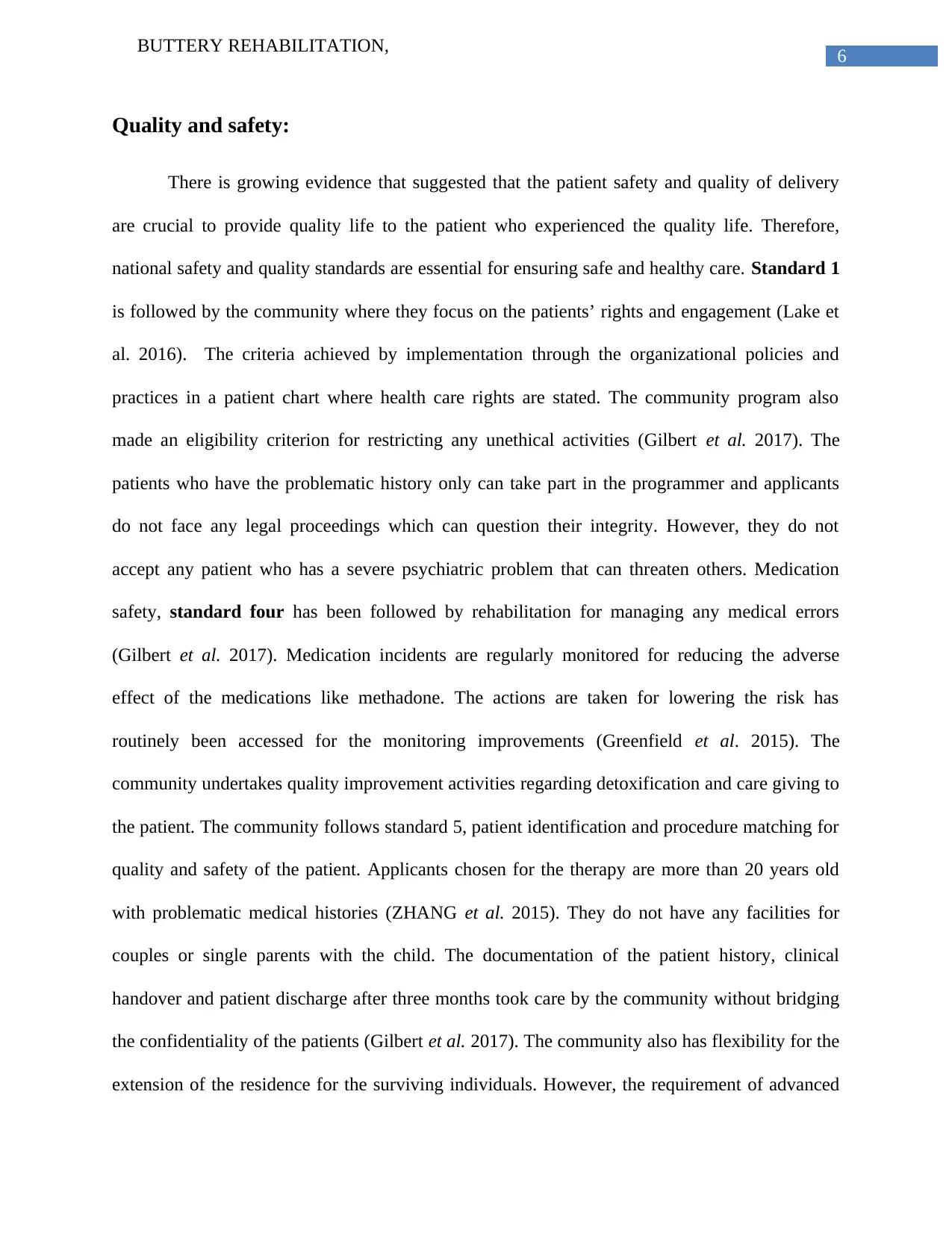
6
BUTTERY REHABILITATION,
Quality and safety:
There is growing evidence that suggested that the patient safety and quality of delivery
are crucial to provide quality life to the patient who experienced the quality life. Therefore,
national safety and quality standards are essential for ensuring safe and healthy care. Standard 1
is followed by the community where they focus on the patients’ rights and engagement (Lake et
al. 2016). The criteria achieved by implementation through the organizational policies and
practices in a patient chart where health care rights are stated. The community program also
made an eligibility criterion for restricting any unethical activities (Gilbert et al. 2017). The
patients who have the problematic history only can take part in the programmer and applicants
do not face any legal proceedings which can question their integrity. However, they do not
accept any patient who has a severe psychiatric problem that can threaten others. Medication
safety, standard four has been followed by rehabilitation for managing any medical errors
(Gilbert et al. 2017). Medication incidents are regularly monitored for reducing the adverse
effect of the medications like methadone. The actions are taken for lowering the risk has
routinely been accessed for the monitoring improvements (Greenfield et al. 2015). The
community undertakes quality improvement activities regarding detoxification and care giving to
the patient. The community follows standard 5, patient identification and procedure matching for
quality and safety of the patient. Applicants chosen for the therapy are more than 20 years old
with problematic medical histories (ZHANG et al. 2015). They do not have any facilities for
couples or single parents with the child. The documentation of the patient history, clinical
handover and patient discharge after three months took care by the community without bridging
the confidentiality of the patients (Gilbert et al. 2017). The community also has flexibility for the
extension of the residence for the surviving individuals. However, the requirement of advanced
BUTTERY REHABILITATION,
Quality and safety:
There is growing evidence that suggested that the patient safety and quality of delivery
are crucial to provide quality life to the patient who experienced the quality life. Therefore,
national safety and quality standards are essential for ensuring safe and healthy care. Standard 1
is followed by the community where they focus on the patients’ rights and engagement (Lake et
al. 2016). The criteria achieved by implementation through the organizational policies and
practices in a patient chart where health care rights are stated. The community program also
made an eligibility criterion for restricting any unethical activities (Gilbert et al. 2017). The
patients who have the problematic history only can take part in the programmer and applicants
do not face any legal proceedings which can question their integrity. However, they do not
accept any patient who has a severe psychiatric problem that can threaten others. Medication
safety, standard four has been followed by rehabilitation for managing any medical errors
(Gilbert et al. 2017). Medication incidents are regularly monitored for reducing the adverse
effect of the medications like methadone. The actions are taken for lowering the risk has
routinely been accessed for the monitoring improvements (Greenfield et al. 2015). The
community undertakes quality improvement activities regarding detoxification and care giving to
the patient. The community follows standard 5, patient identification and procedure matching for
quality and safety of the patient. Applicants chosen for the therapy are more than 20 years old
with problematic medical histories (ZHANG et al. 2015). They do not have any facilities for
couples or single parents with the child. The documentation of the patient history, clinical
handover and patient discharge after three months took care by the community without bridging
the confidentiality of the patients (Gilbert et al. 2017). The community also has flexibility for the
extension of the residence for the surviving individuals. However, the requirement of advanced
Paraphrase This Document
Need a fresh take? Get an instant paraphrase of this document with our AI Paraphraser
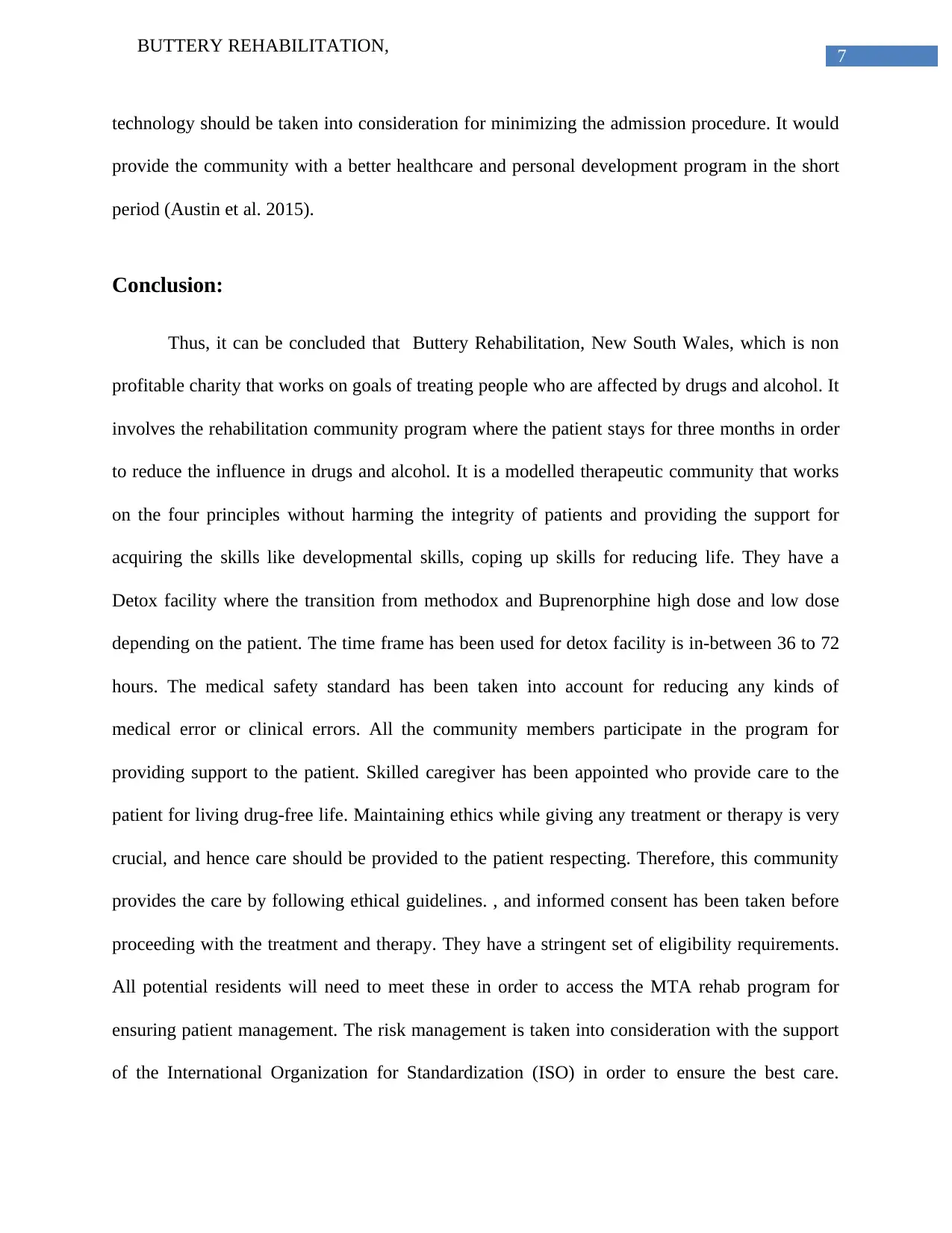
7
BUTTERY REHABILITATION,
technology should be taken into consideration for minimizing the admission procedure. It would
provide the community with a better healthcare and personal development program in the short
period (Austin et al. 2015).
Conclusion:
Thus, it can be concluded that Buttery Rehabilitation, New South Wales, which is non
profitable charity that works on goals of treating people who are affected by drugs and alcohol. It
involves the rehabilitation community program where the patient stays for three months in order
to reduce the influence in drugs and alcohol. It is a modelled therapeutic community that works
on the four principles without harming the integrity of patients and providing the support for
acquiring the skills like developmental skills, coping up skills for reducing life. They have a
Detox facility where the transition from methodox and Buprenorphine high dose and low dose
depending on the patient. The time frame has been used for detox facility is in-between 36 to 72
hours. The medical safety standard has been taken into account for reducing any kinds of
medical error or clinical errors. All the community members participate in the program for
providing support to the patient. Skilled caregiver has been appointed who provide care to the
patient for living drug-free life. Maintaining ethics while giving any treatment or therapy is very
crucial, and hence care should be provided to the patient respecting. Therefore, this community
provides the care by following ethical guidelines. , and informed consent has been taken before
proceeding with the treatment and therapy. They have a stringent set of eligibility requirements.
All potential residents will need to meet these in order to access the MTA rehab program for
ensuring patient management. The risk management is taken into consideration with the support
of the International Organization for Standardization (ISO) in order to ensure the best care.
BUTTERY REHABILITATION,
technology should be taken into consideration for minimizing the admission procedure. It would
provide the community with a better healthcare and personal development program in the short
period (Austin et al. 2015).
Conclusion:
Thus, it can be concluded that Buttery Rehabilitation, New South Wales, which is non
profitable charity that works on goals of treating people who are affected by drugs and alcohol. It
involves the rehabilitation community program where the patient stays for three months in order
to reduce the influence in drugs and alcohol. It is a modelled therapeutic community that works
on the four principles without harming the integrity of patients and providing the support for
acquiring the skills like developmental skills, coping up skills for reducing life. They have a
Detox facility where the transition from methodox and Buprenorphine high dose and low dose
depending on the patient. The time frame has been used for detox facility is in-between 36 to 72
hours. The medical safety standard has been taken into account for reducing any kinds of
medical error or clinical errors. All the community members participate in the program for
providing support to the patient. Skilled caregiver has been appointed who provide care to the
patient for living drug-free life. Maintaining ethics while giving any treatment or therapy is very
crucial, and hence care should be provided to the patient respecting. Therefore, this community
provides the care by following ethical guidelines. , and informed consent has been taken before
proceeding with the treatment and therapy. They have a stringent set of eligibility requirements.
All potential residents will need to meet these in order to access the MTA rehab program for
ensuring patient management. The risk management is taken into consideration with the support
of the International Organization for Standardization (ISO) in order to ensure the best care.
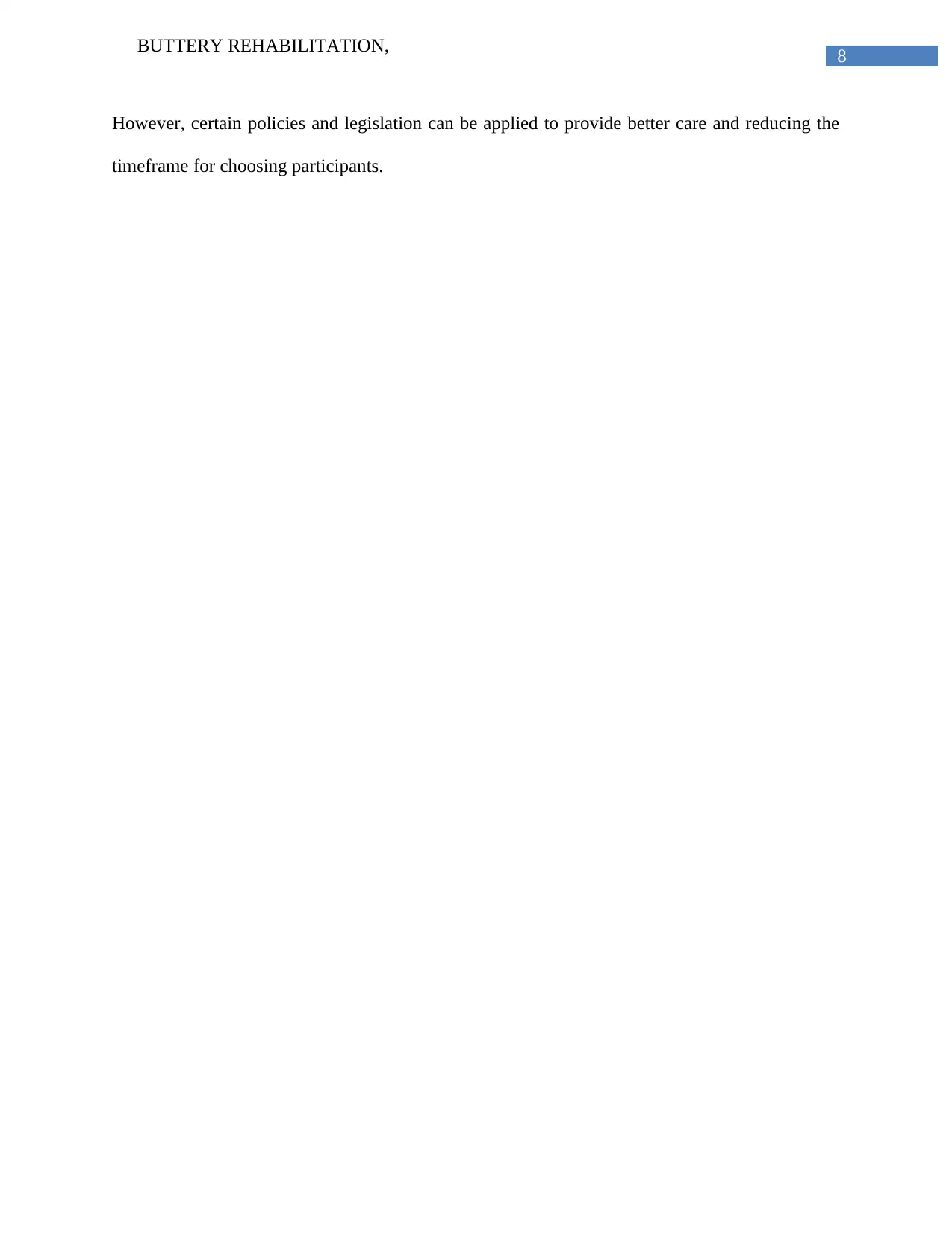
8
BUTTERY REHABILITATION,
However, certain policies and legislation can be applied to provide better care and reducing the
timeframe for choosing participants.
BUTTERY REHABILITATION,
However, certain policies and legislation can be applied to provide better care and reducing the
timeframe for choosing participants.
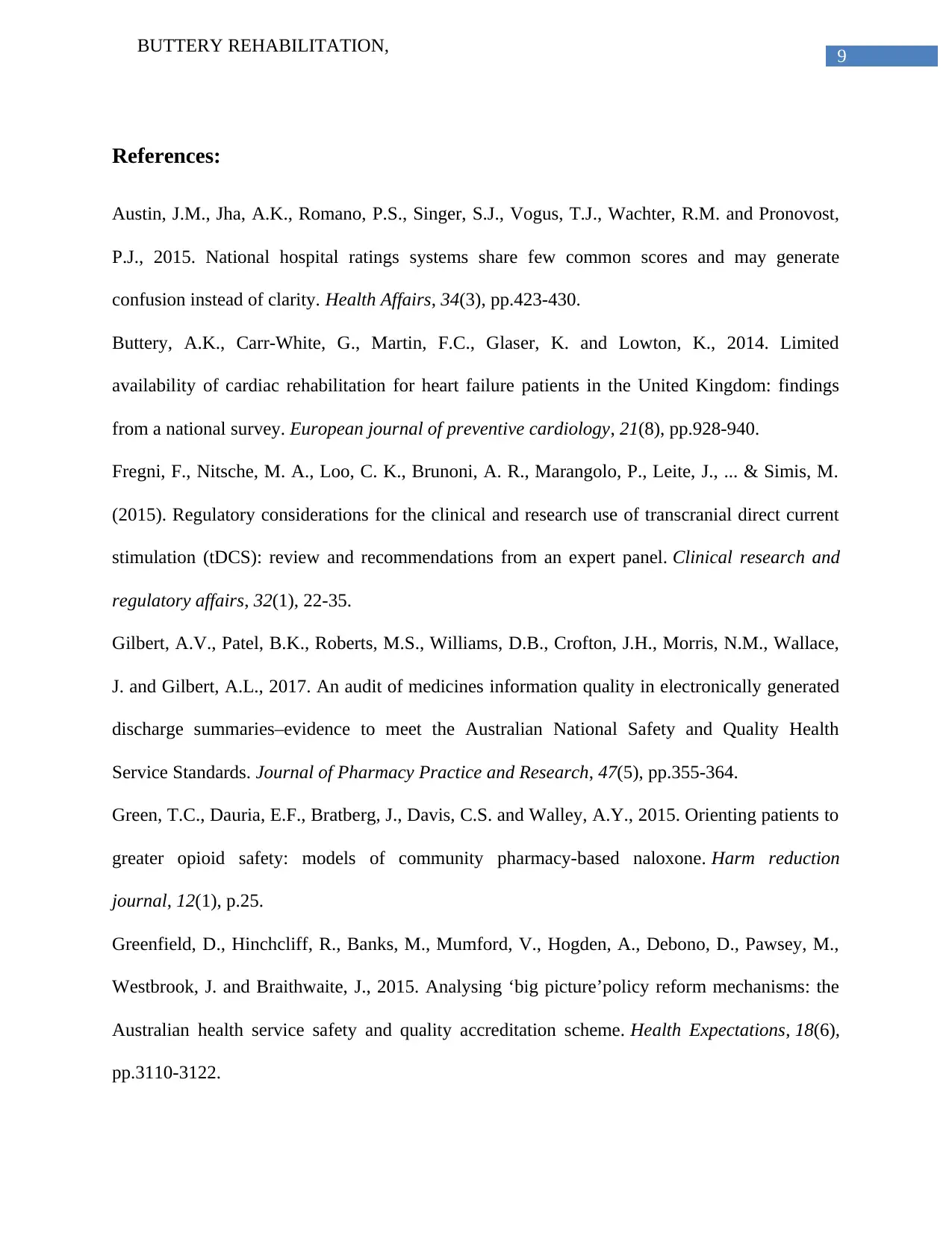
9
BUTTERY REHABILITATION,
References:
Austin, J.M., Jha, A.K., Romano, P.S., Singer, S.J., Vogus, T.J., Wachter, R.M. and Pronovost,
P.J., 2015. National hospital ratings systems share few common scores and may generate
confusion instead of clarity. Health Affairs, 34(3), pp.423-430.
Buttery, A.K., Carr-White, G., Martin, F.C., Glaser, K. and Lowton, K., 2014. Limited
availability of cardiac rehabilitation for heart failure patients in the United Kingdom: findings
from a national survey. European journal of preventive cardiology, 21(8), pp.928-940.
Fregni, F., Nitsche, M. A., Loo, C. K., Brunoni, A. R., Marangolo, P., Leite, J., ... & Simis, M.
(2015). Regulatory considerations for the clinical and research use of transcranial direct current
stimulation (tDCS): review and recommendations from an expert panel. Clinical research and
regulatory affairs, 32(1), 22-35.
Gilbert, A.V., Patel, B.K., Roberts, M.S., Williams, D.B., Crofton, J.H., Morris, N.M., Wallace,
J. and Gilbert, A.L., 2017. An audit of medicines information quality in electronically generated
discharge summaries–evidence to meet the Australian National Safety and Quality Health
Service Standards. Journal of Pharmacy Practice and Research, 47(5), pp.355-364.
Green, T.C., Dauria, E.F., Bratberg, J., Davis, C.S. and Walley, A.Y., 2015. Orienting patients to
greater opioid safety: models of community pharmacy-based naloxone. Harm reduction
journal, 12(1), p.25.
Greenfield, D., Hinchcliff, R., Banks, M., Mumford, V., Hogden, A., Debono, D., Pawsey, M.,
Westbrook, J. and Braithwaite, J., 2015. Analysing ‘big picture’policy reform mechanisms: the
Australian health service safety and quality accreditation scheme. Health Expectations, 18(6),
pp.3110-3122.
BUTTERY REHABILITATION,
References:
Austin, J.M., Jha, A.K., Romano, P.S., Singer, S.J., Vogus, T.J., Wachter, R.M. and Pronovost,
P.J., 2015. National hospital ratings systems share few common scores and may generate
confusion instead of clarity. Health Affairs, 34(3), pp.423-430.
Buttery, A.K., Carr-White, G., Martin, F.C., Glaser, K. and Lowton, K., 2014. Limited
availability of cardiac rehabilitation for heart failure patients in the United Kingdom: findings
from a national survey. European journal of preventive cardiology, 21(8), pp.928-940.
Fregni, F., Nitsche, M. A., Loo, C. K., Brunoni, A. R., Marangolo, P., Leite, J., ... & Simis, M.
(2015). Regulatory considerations for the clinical and research use of transcranial direct current
stimulation (tDCS): review and recommendations from an expert panel. Clinical research and
regulatory affairs, 32(1), 22-35.
Gilbert, A.V., Patel, B.K., Roberts, M.S., Williams, D.B., Crofton, J.H., Morris, N.M., Wallace,
J. and Gilbert, A.L., 2017. An audit of medicines information quality in electronically generated
discharge summaries–evidence to meet the Australian National Safety and Quality Health
Service Standards. Journal of Pharmacy Practice and Research, 47(5), pp.355-364.
Green, T.C., Dauria, E.F., Bratberg, J., Davis, C.S. and Walley, A.Y., 2015. Orienting patients to
greater opioid safety: models of community pharmacy-based naloxone. Harm reduction
journal, 12(1), p.25.
Greenfield, D., Hinchcliff, R., Banks, M., Mumford, V., Hogden, A., Debono, D., Pawsey, M.,
Westbrook, J. and Braithwaite, J., 2015. Analysing ‘big picture’policy reform mechanisms: the
Australian health service safety and quality accreditation scheme. Health Expectations, 18(6),
pp.3110-3122.
Secure Best Marks with AI Grader
Need help grading? Try our AI Grader for instant feedback on your assignments.
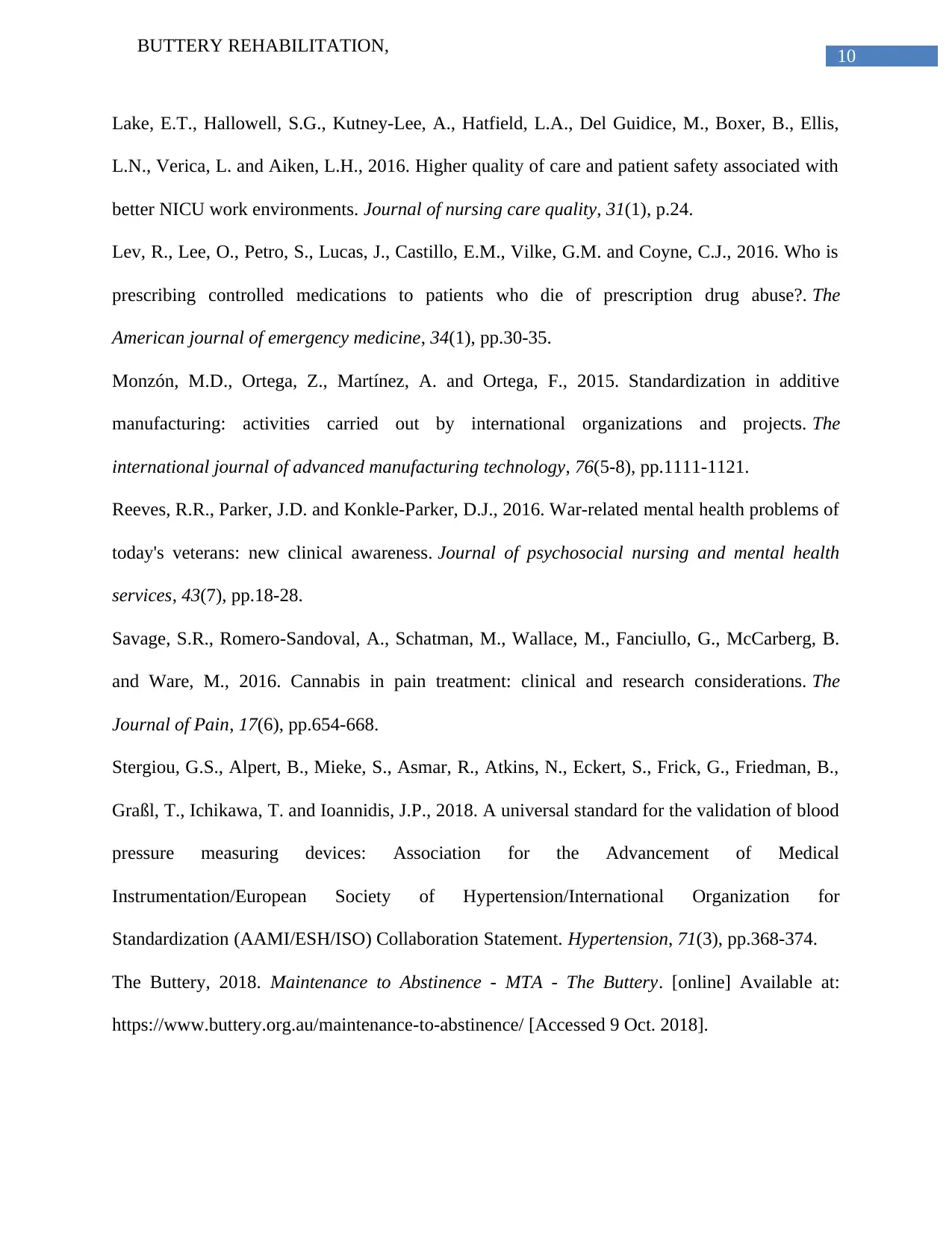
10
BUTTERY REHABILITATION,
Lake, E.T., Hallowell, S.G., Kutney-Lee, A., Hatfield, L.A., Del Guidice, M., Boxer, B., Ellis,
L.N., Verica, L. and Aiken, L.H., 2016. Higher quality of care and patient safety associated with
better NICU work environments. Journal of nursing care quality, 31(1), p.24.
Lev, R., Lee, O., Petro, S., Lucas, J., Castillo, E.M., Vilke, G.M. and Coyne, C.J., 2016. Who is
prescribing controlled medications to patients who die of prescription drug abuse?. The
American journal of emergency medicine, 34(1), pp.30-35.
Monzón, M.D., Ortega, Z., Martínez, A. and Ortega, F., 2015. Standardization in additive
manufacturing: activities carried out by international organizations and projects. The
international journal of advanced manufacturing technology, 76(5-8), pp.1111-1121.
Reeves, R.R., Parker, J.D. and Konkle-Parker, D.J., 2016. War-related mental health problems of
today's veterans: new clinical awareness. Journal of psychosocial nursing and mental health
services, 43(7), pp.18-28.
Savage, S.R., Romero-Sandoval, A., Schatman, M., Wallace, M., Fanciullo, G., McCarberg, B.
and Ware, M., 2016. Cannabis in pain treatment: clinical and research considerations. The
Journal of Pain, 17(6), pp.654-668.
Stergiou, G.S., Alpert, B., Mieke, S., Asmar, R., Atkins, N., Eckert, S., Frick, G., Friedman, B.,
Graßl, T., Ichikawa, T. and Ioannidis, J.P., 2018. A universal standard for the validation of blood
pressure measuring devices: Association for the Advancement of Medical
Instrumentation/European Society of Hypertension/International Organization for
Standardization (AAMI/ESH/ISO) Collaboration Statement. Hypertension, 71(3), pp.368-374.
The Buttery, 2018. Maintenance to Abstinence - MTA - The Buttery. [online] Available at:
https://www.buttery.org.au/maintenance-to-abstinence/ [Accessed 9 Oct. 2018].
BUTTERY REHABILITATION,
Lake, E.T., Hallowell, S.G., Kutney-Lee, A., Hatfield, L.A., Del Guidice, M., Boxer, B., Ellis,
L.N., Verica, L. and Aiken, L.H., 2016. Higher quality of care and patient safety associated with
better NICU work environments. Journal of nursing care quality, 31(1), p.24.
Lev, R., Lee, O., Petro, S., Lucas, J., Castillo, E.M., Vilke, G.M. and Coyne, C.J., 2016. Who is
prescribing controlled medications to patients who die of prescription drug abuse?. The
American journal of emergency medicine, 34(1), pp.30-35.
Monzón, M.D., Ortega, Z., Martínez, A. and Ortega, F., 2015. Standardization in additive
manufacturing: activities carried out by international organizations and projects. The
international journal of advanced manufacturing technology, 76(5-8), pp.1111-1121.
Reeves, R.R., Parker, J.D. and Konkle-Parker, D.J., 2016. War-related mental health problems of
today's veterans: new clinical awareness. Journal of psychosocial nursing and mental health
services, 43(7), pp.18-28.
Savage, S.R., Romero-Sandoval, A., Schatman, M., Wallace, M., Fanciullo, G., McCarberg, B.
and Ware, M., 2016. Cannabis in pain treatment: clinical and research considerations. The
Journal of Pain, 17(6), pp.654-668.
Stergiou, G.S., Alpert, B., Mieke, S., Asmar, R., Atkins, N., Eckert, S., Frick, G., Friedman, B.,
Graßl, T., Ichikawa, T. and Ioannidis, J.P., 2018. A universal standard for the validation of blood
pressure measuring devices: Association for the Advancement of Medical
Instrumentation/European Society of Hypertension/International Organization for
Standardization (AAMI/ESH/ISO) Collaboration Statement. Hypertension, 71(3), pp.368-374.
The Buttery, 2018. Maintenance to Abstinence - MTA - The Buttery. [online] Available at:
https://www.buttery.org.au/maintenance-to-abstinence/ [Accessed 9 Oct. 2018].
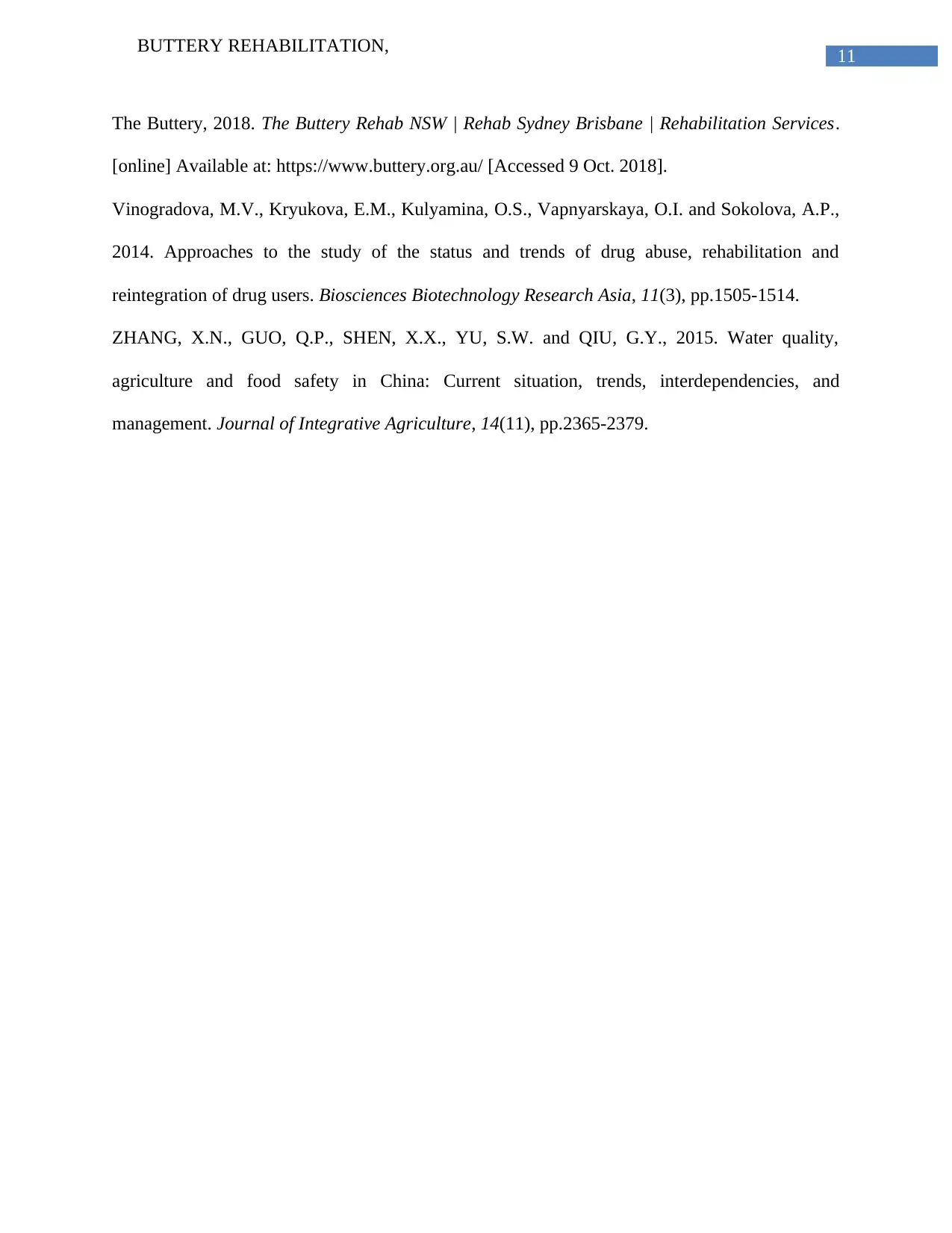
11
BUTTERY REHABILITATION,
The Buttery, 2018. The Buttery Rehab NSW | Rehab Sydney Brisbane | Rehabilitation Services.
[online] Available at: https://www.buttery.org.au/ [Accessed 9 Oct. 2018].
Vinogradova, M.V., Kryukova, E.M., Kulyamina, O.S., Vapnyarskaya, O.I. and Sokolova, A.P.,
2014. Approaches to the study of the status and trends of drug abuse, rehabilitation and
reintegration of drug users. Biosciences Biotechnology Research Asia, 11(3), pp.1505-1514.
ZHANG, X.N., GUO, Q.P., SHEN, X.X., YU, S.W. and QIU, G.Y., 2015. Water quality,
agriculture and food safety in China: Current situation, trends, interdependencies, and
management. Journal of Integrative Agriculture, 14(11), pp.2365-2379.
BUTTERY REHABILITATION,
The Buttery, 2018. The Buttery Rehab NSW | Rehab Sydney Brisbane | Rehabilitation Services.
[online] Available at: https://www.buttery.org.au/ [Accessed 9 Oct. 2018].
Vinogradova, M.V., Kryukova, E.M., Kulyamina, O.S., Vapnyarskaya, O.I. and Sokolova, A.P.,
2014. Approaches to the study of the status and trends of drug abuse, rehabilitation and
reintegration of drug users. Biosciences Biotechnology Research Asia, 11(3), pp.1505-1514.
ZHANG, X.N., GUO, Q.P., SHEN, X.X., YU, S.W. and QIU, G.Y., 2015. Water quality,
agriculture and food safety in China: Current situation, trends, interdependencies, and
management. Journal of Integrative Agriculture, 14(11), pp.2365-2379.
1 out of 12
Your All-in-One AI-Powered Toolkit for Academic Success.
+13062052269
info@desklib.com
Available 24*7 on WhatsApp / Email
![[object Object]](/_next/static/media/star-bottom.7253800d.svg)
Unlock your academic potential
© 2024 | Zucol Services PVT LTD | All rights reserved.